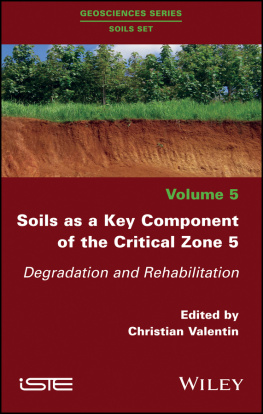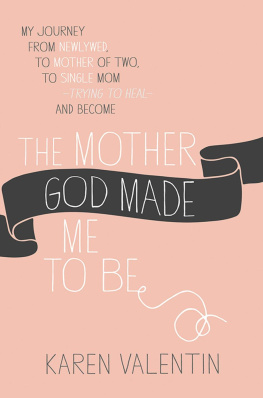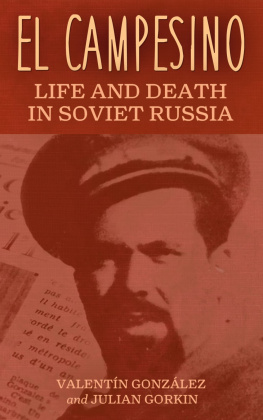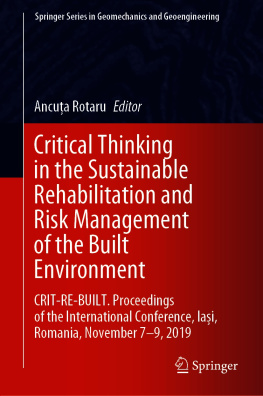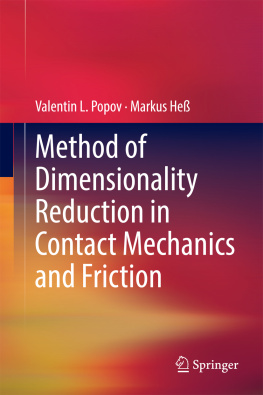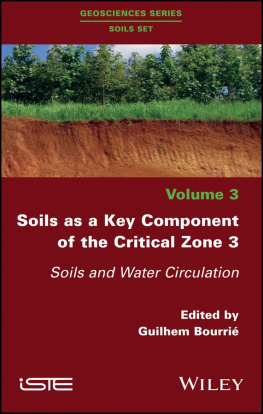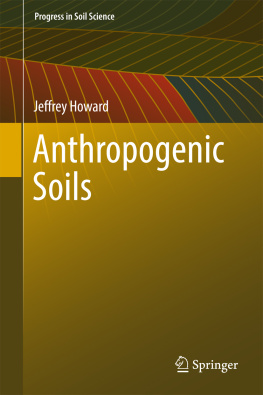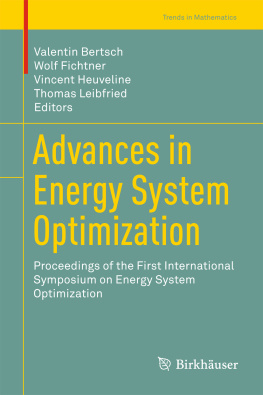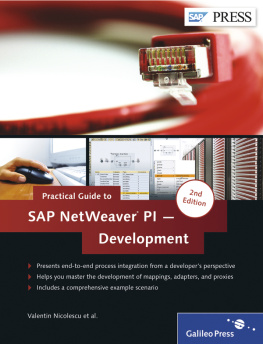Valentin - Soils as a key component of the critical zone degradation and rehabilitation: 5 :
Here you can read online Valentin - Soils as a key component of the critical zone degradation and rehabilitation: 5 : full text of the book (entire story) in english for free. Download pdf and epub, get meaning, cover and reviews about this ebook. City: London;Hoboken;NJ, year: 2018, publisher: ISTE;John Wiley & Sons, genre: Romance novel. Description of the work, (preface) as well as reviews are available. Best literature library LitArk.com created for fans of good reading and offers a wide selection of genres:
Romance novel
Science fiction
Adventure
Detective
Science
History
Home and family
Prose
Art
Politics
Computer
Non-fiction
Religion
Business
Children
Humor
Choose a favorite category and find really read worthwhile books. Enjoy immersion in the world of imagination, feel the emotions of the characters or learn something new for yourself, make an fascinating discovery.
- Book:Soils as a key component of the critical zone degradation and rehabilitation: 5 :
- Author:
- Publisher:ISTE;John Wiley & Sons
- Genre:
- Year:2018
- City:London;Hoboken;NJ
- Rating:5 / 5
- Favourites:Add to favourites
- Your mark:
- 100
- 1
- 2
- 3
- 4
- 5
Soils as a key component of the critical zone degradation and rehabilitation: 5 :: summary, description and annotation
We offer to read an annotation, description, summary or preface (depends on what the author of the book "Soils as a key component of the critical zone degradation and rehabilitation: 5 :" wrote himself). If you haven't found the necessary information about the book — write in the comments, we will try to find it.
Valentin: author's other books
Who wrote Soils as a key component of the critical zone degradation and rehabilitation: 5 :? Find out the surname, the name of the author of the book and a list of all author's works by series.
Soils as a key component of the critical zone degradation and rehabilitation: 5 : — read online for free the complete book (whole text) full work
Below is the text of the book, divided by pages. System saving the place of the last page read, allows you to conveniently read the book "Soils as a key component of the critical zone degradation and rehabilitation: 5 :" online for free, without having to search again every time where you left off. Put a bookmark, and you can go to the page where you finished reading at any time.
Font size:
Interval:
Bookmark:

Soils Set coordinated by Christian Valentin
Series Editor Andr Mariotti
Volume 5
Edited by
Christian Valentin

First published 2018 in Great Britain and the United States by ISTE Ltd and John Wiley & Sons, Inc.
Apart from any fair dealing for the purposes of research or private study, or criticism or review, as permitted under the Copyright, Designs and Patents Act 1988, this publication may only be reproduced, stored or transmitted, in any form or by any means, with the prior permission in writing of the publishers, or in the case of reprographic reproduction in accordance with the terms and licenses issued by the CLA. Enquiries concerning reproduction outside these terms should be sent to the publishers at the undermentioned address:
ISTE Ltd
27-37 St Georges Road
London SW19 4EU
UK
www.iste.co.uk
John Wiley & Sons, Inc.
111 River Street
Hoboken, NJ 07030
USA
www.wiley.com
ISTE Ltd 2018
The rights of Christian Valentin to be identified as the author of this work have been asserted by him in accordance with the Copyright, Designs and Patents Act 1988.
Library of Congress Control Number: 2018957297
British Library Cataloguing-in-Publication Data
A CIP record for this book is available from the British Library
ISBN 978-1-78630-219-9
ISTEs scientific publications include a pluridisciplinary editorial sphere entitled Earth Systems Environmental Sciences and, within this domain, we are now pleased to release a series of works entitled Soils, coordinated by Christian Valentin, as part of the activities of the working group on soils at the Acadmie dAgriculture de France (French Academy of Agriculture).
The general title of this series of works, Soils as a Key Component of the Critical Zone merits a number of comments.
The Critical Zone (CZ), a concept which is now globally recognized, designates the location of interactions between the atmosphere, the hydrosphere, the pedosphere the outermost layer of the Earths crust, made up of soils and subject to the processes for soil formation, derived from interactions with the other surface components the lithosphere and ecosystems. Within this zone, there are vital exchanges of water, matter and energy, such exchanges interacting with those of other layers, both oceanic and atmospheric, within the Earth system. Its extreme reactivity, whether physical, chemical or biological, is an essential factor of the overall regulation of this Earth system.
Supporting all forms of life, this thin layer has a high level of interaction with human activities. Examples of these are agriculture, urbanization, resource extraction, waste management and economic activities.
This concept of the Critical Zone (CZ) entirely revives the environmental approach, simultaneously enabling an integrated, descriptive, explanatory and predictive view of the Earth system, of its major biogeochemical cycles and their interaction with the climate system. The view becomes dynamic, explaining all interactions, and opens the way for predictive modeling. Such processes are necessarily integrated with given models, paying special attention to the hydrological cycle as well as the carbon and nitrogen cycles.
Within the CZ, soil is a key component, playing a prominent role in the storage, dynamics and conversion of biogenic elements (carbon, nitrogen, phosphorous C, N, P) and of all inorganic, organic or microbiological contaminants. This contributes to significantly affecting the quantity and the quality of the essential resources for human activity, these being soils, water and air quality.
Soils thus return to the top of the international agenda, as a result of the major challenges for any civilization. These include agricultural production, climate change, changes and conflicts over land use (deforestation, urbanization, land grabbing and others), biodiversity, major cycles (water, carbon (C), nitrogen (N) and phosphorous (P)), pollution, health, waste, the circular economy, and so on. They appear therefore legitimately within the United Nations sustainable development goals by 2030 (SDG 15: Protect, restore and promote sustainable use of terrestrial ecosystems, sustainably manage forests, combat desertification, and halt and reverse land degradation and halt biodiversity loss).
The study of soils, as a key component of the Critical Zone, should thus not only be tackled by soil science but also within the highly numerous disciplines of Earth and life sciences, humanities and social sciences. Soils, being as they are at the center of multiple interactions, are an intricate array of systems, a nexus joining the essential parameters. These are food, water, energy, climate and biodiversity.
Soils, in terms of structure and dynamics, with complex processes, are sensitive to global changes that induce developments, which themselves obey threshold processes and issues of resilience. These involve, with regard to their study, taking into account not only short but also long time spans. This aspect was stressed in a white paper on soils published by the CNRS in 2015 (available at the address: www.insu.cnrs.fr/node/5432). The dynamics of major biogeochemical cycles, in particular with timescale characteristics which can be centuries old, indeed even go further back beyond that and so on.
It is clear that among the major components of the environment discussed earlier, soils are the least understood by the general public, by the authorities and even in academic circles. Consequently, it becomes of prime importance to provide the conceptual bases to the greatest number of university teachers and students so as to tackle soils with the complexity of their nature, their mechanics, their diversity and their interactions with other components, within the Critical Zone.
This is what is achieved with the reflections, analyses and the prospective studies carried out by all of the authors in this series. They are top scientists with a high level of international expertise within their discipline, and are mindful of adopting a holistic approach to soil study. The authors of this series pay specific attention to aspects able to be concluded through an open interdisciplinary science, beyond the single scientific community, policymakers, managers and to all those who are interested in the evolution of our planet. These authors also support their scientific reflection in line with training demands and, of course, the broadest dissemination of knowledge.
The series takes the form of six volumes:
- Soils as a Key Component of the Critical Zone 1: Functions and Services, a volume which will serve as a general introduction;
- Soils as a Key Component of the Critical Zone 2: Societal Issues;
- Soils as a Key Component of the Critical Zone 3: Soils and Water Circulation;
- Soils as a Key Component of the Critical Zone 4: Soils and Water Quality;
- Soils as a Key Component of the Critical Zone 5: Degradation and Rehabilitation; and
- Soils as a Key Component of the Critical Zone 6: Ecology.
Finally, it is worth mentioning again that this series was prepared essentially within the working group Soils at the Acadmie dAgriculture de France, under the debonair, yet tenacious and assertive, stewardship of Christian Valentin. We are grateful to this group of scientists and their leader for producing this series.
Next pageFont size:
Interval:
Bookmark:
Similar books «Soils as a key component of the critical zone degradation and rehabilitation: 5 :»
Look at similar books to Soils as a key component of the critical zone degradation and rehabilitation: 5 :. We have selected literature similar in name and meaning in the hope of providing readers with more options to find new, interesting, not yet read works.
Discussion, reviews of the book Soils as a key component of the critical zone degradation and rehabilitation: 5 : and just readers' own opinions. Leave your comments, write what you think about the work, its meaning or the main characters. Specify what exactly you liked and what you didn't like, and why you think so.

